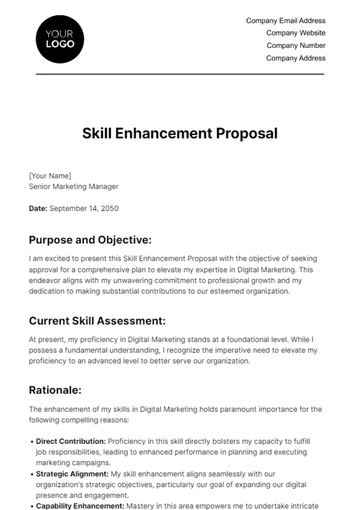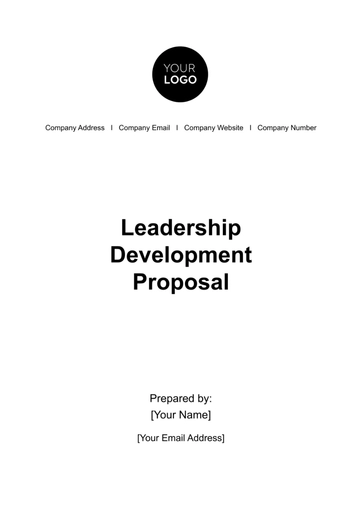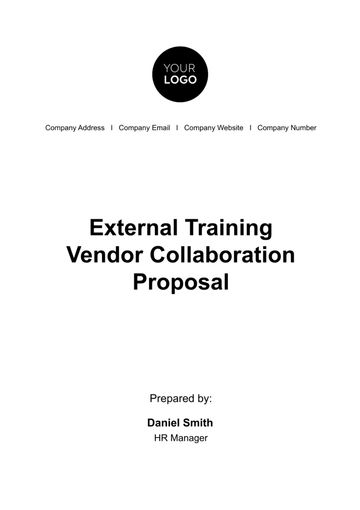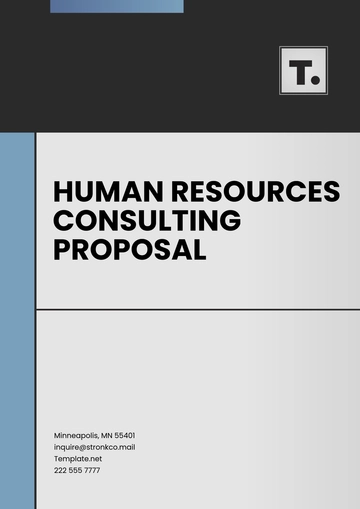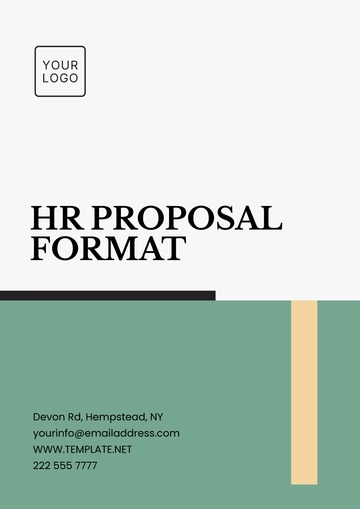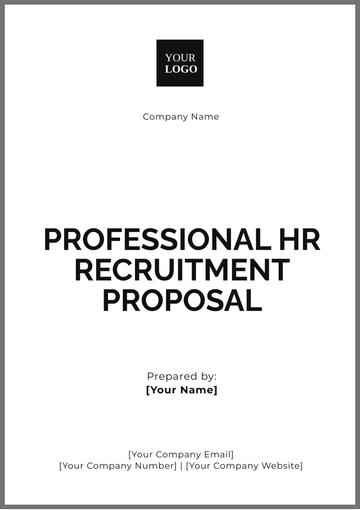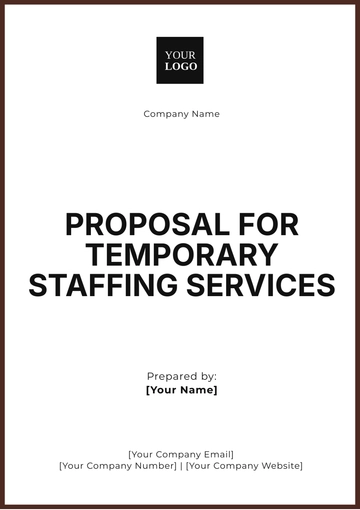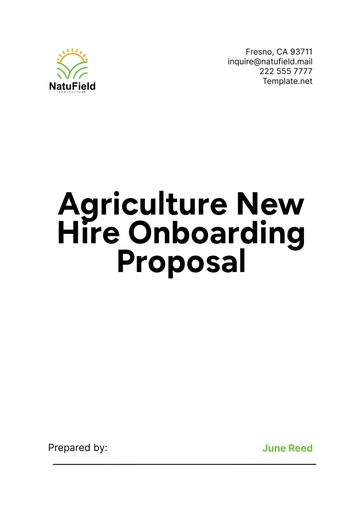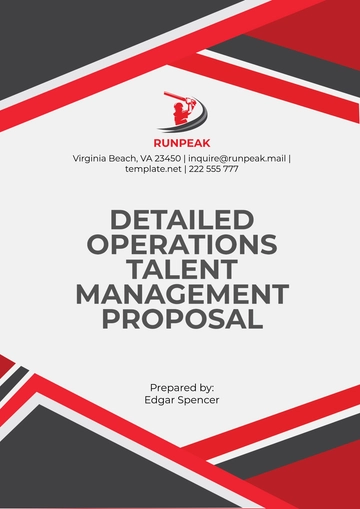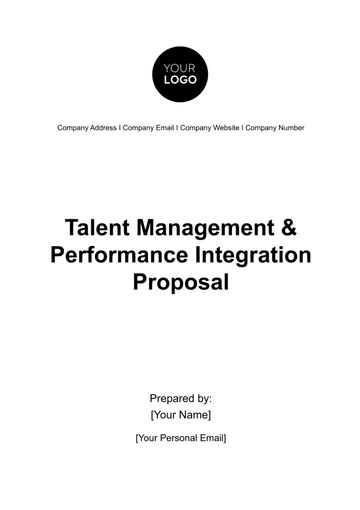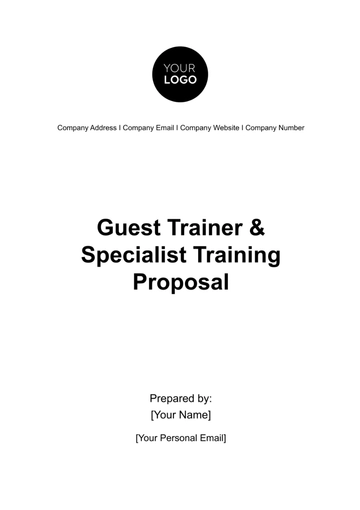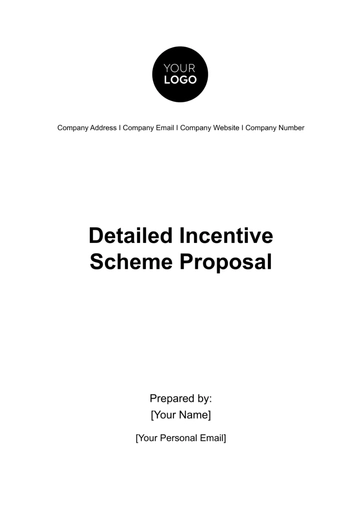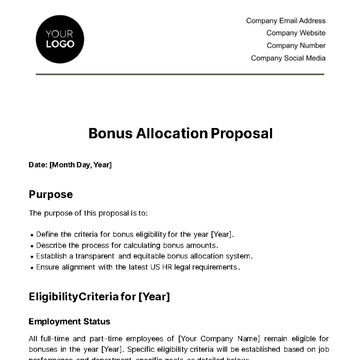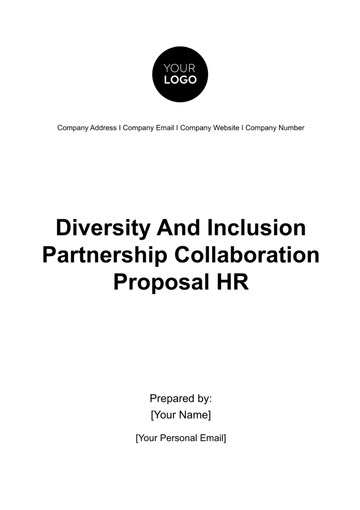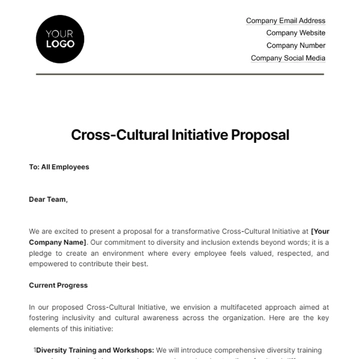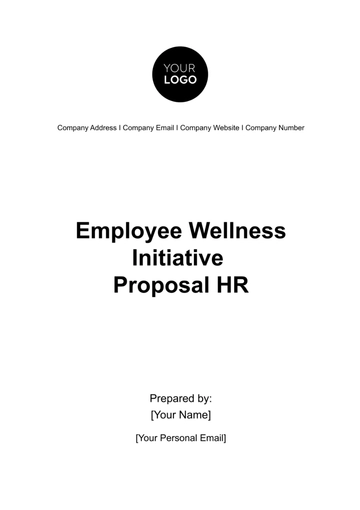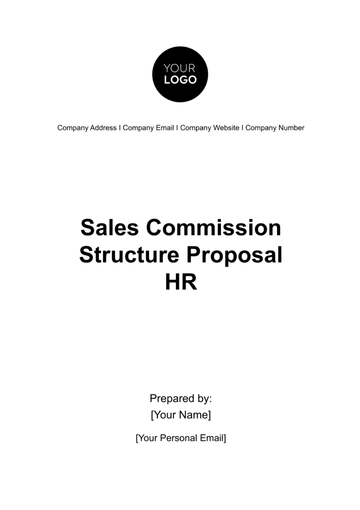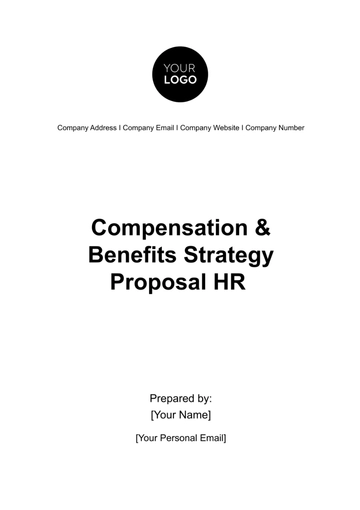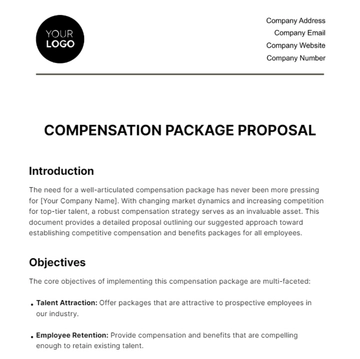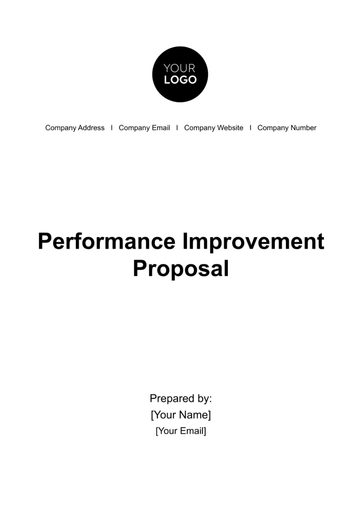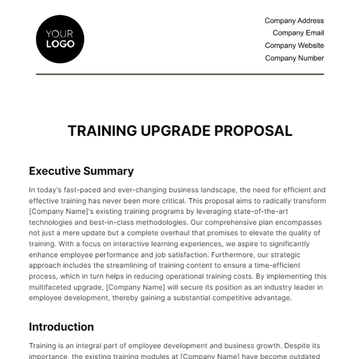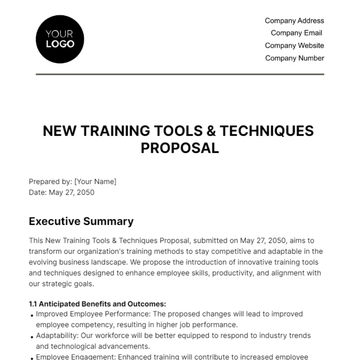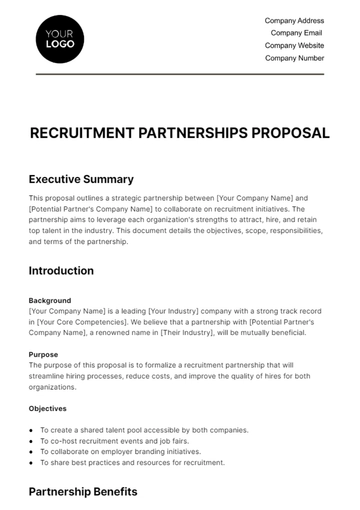Free Compensation & Benefits Strategy Proposal HR
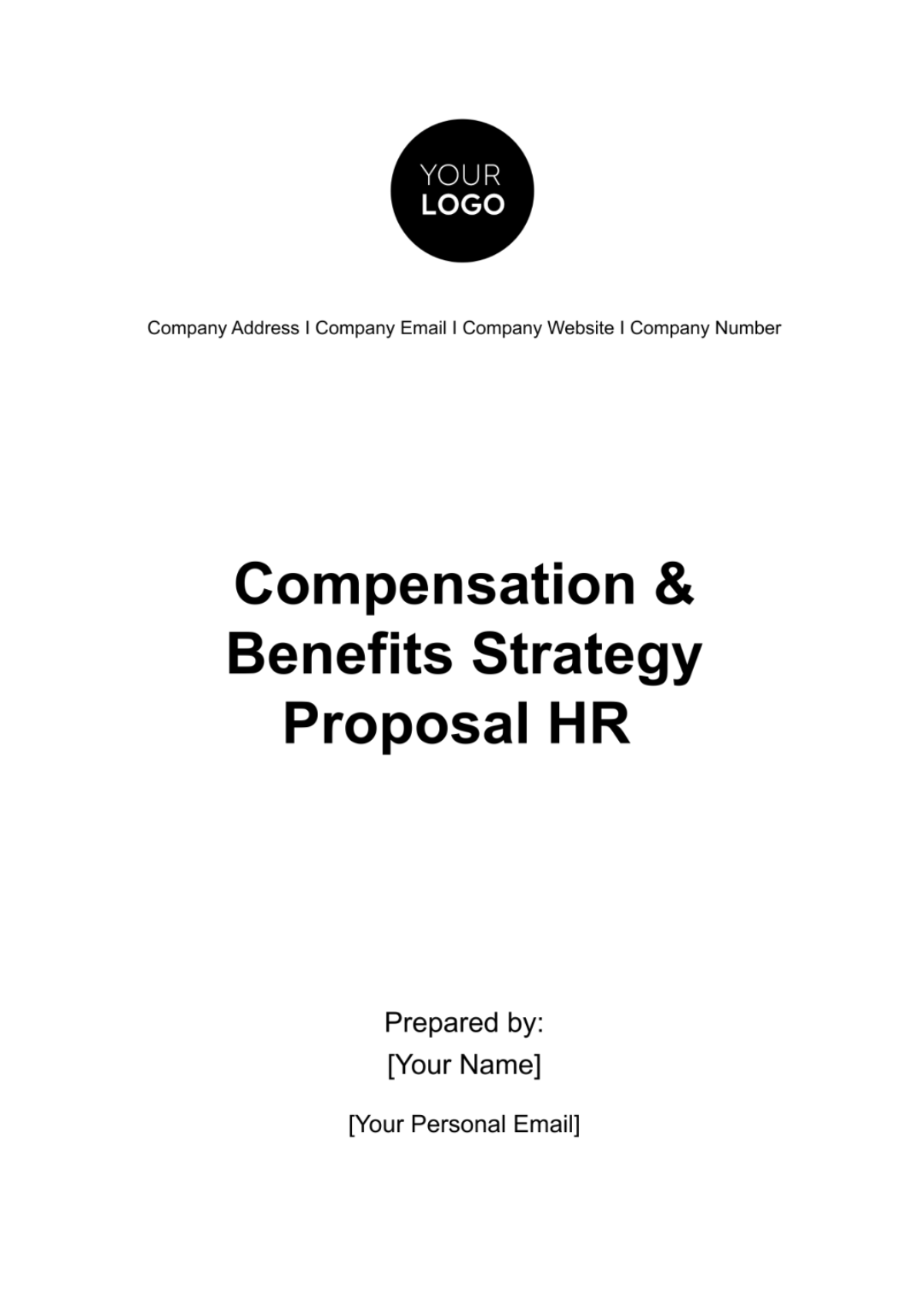
Proposal HR
EXECUTIVE SUMMARY
In this dynamic business landscape, [Your Company Name] recognizes the pivotal role that a robust Compensation and Benefits Strategy plays in attracting, retaining, and motivating top-tier talent. This proposal outlines a comprehensive strategy designed to align with your organization's vision, enhance competitiveness, and elevate employee satisfaction.
Our strategy encompasses a holistic approach to compensation, benefits, and rewards, underpinned by market insights and compliance considerations. We aim to create a workplace where employees are not only valued for their contributions but also empowered to achieve their career aspirations.
INTRODUCTION
In today's competitive job market, where talent is the driving force behind an organization's success, a well-crafted Compensation and Benefits Strategy is not merely an option—it is a strategic imperative. At [Your Company Name], we understand that our employees are the lifeblood of our organization, and investing in their well-being is paramount.
This proposal is rooted in our commitment to maintaining a thriving, engaged workforce and a company culture that fosters innovation and growth. By addressing the multifaceted aspects of compensation, benefits, and total rewards, we intend to create a work environment that attracts top-tier talent, retains our valued employees, and empowers them to excel.
OBJECTIVES
Our Compensation and Benefits Strategy has been formulated with the following objectives in mind:
Attract Top Talent: We intend to craft and offer competitive compensation packages that are not only attractive but also conducive to attracting exceptional candidates who align with our organizational values and mission.
Retain Key Employees: Through retention-focused benefits and initiatives, we aim to reduce turnover rates and retain our valuable talent pool.
Motivate and Engage: We plan to align compensation with performance by introducing performance-based pay elements, which will not only motivate employees but also enhance their engagement with the organization.
Ensure Compliance: To adapt to evolving labor laws and regulations, we remain committed to ensuring that our compensation and benefits practices are in full compliance with the legal landscape.
STRATEGY OVERVIEW
Compensation Structure
Market Analysis: Our strategy commences with an extensive industry and local market analysis. This analysis will serve as the foundation for our compensation structure adjustments, enabling us to remain competitive and attractive to potential hires.
Salary Structure: We propose a revision of our salary structure to reflect the market trends and simultaneously align with the financial goals of our organization.
Performance-Based Pay: Recognizing the importance of performance, we plan to introduce performance-based pay components that reward top performers and provide clear incentives for excellence.
Benefits Package
The following table lists the benefits packages and their descriptions. These aim to enhance employee well-being and work-life balance.
BENEFIT | DESCRIPTION |
|---|---|
Health and Wellness | Enhance health benefits to include comprehensive preventive and mental health services. Explore wellness initiatives designed to promote overall well-being. |
Retirement Benefits | Review and potentially expand our retirement offerings, including 401(k) matching and additional financial planning resources. Consider offering flexible work arrangements to support work-life balance. |
Paid Time Off (PTO) | Offer a competitive PTO policy, including vacation days, holidays, and personal time, to encourage rest and rejuvenation. |
Family Leave | Provide family-friendly benefits such as paid parental leave, adoption assistance, and caregiving support. |
Employee Assistance Program (EAP) | Offer an EAP to provide employees and their families with access to confidential counseling and support services. |
Health Savings Account (HSA) | Facilitate savings for healthcare expenses by providing access to HSAs with employer contributions. |
Commuter Benefits | Support employees' commuting costs with benefits like public transit subsidies or parking assistance. |
Tuition Reimbursement | Encourage continuous learning and development by offering financial assistance for further education. |
Employee Discounts | Provide discounts or exclusive deals on company products/services or partnerships with external brands. |
Professional Development | Invest in employees' professional growth by sponsoring certifications, workshops, and industry conferences. |
Employee Recognition | Implement a robust recognition program to acknowledge and reward outstanding performance and achievements. |
Flexible Spending Accounts (FSA) | Offer FSAs to enable employees to set aside pre-tax funds for eligible healthcare and dependent care expenses. |
Legal Assistance | Provide access to legal advice and services, helping employees navigate personal legal matters. |
Wellness Programs | Promote physical and mental well-being through initiatives like fitness classes, stress management workshops, and health challenges. |
Total Rewards
The table below lists the rewards and their descriptions. These recognize and reward outstanding employee performance.
REWARD | DESCRIPTION |
|---|---|
Recognition Programs | Develop robust recognition and rewards programs to acknowledge and celebrate outstanding performance and contributions. |
Training and Development | Invest in the growth and development of our employees through tailored training and development programs. |
Employee Appreciation Events | Organize special events, outings, or activities to celebrate employee achievements and milestones. |
Performance Bonuses | Implement performance-based bonuses or incentives for individuals or teams that exceed their goals and targets. |
Extra Paid Time Off | Offer additional paid time off days as a reward for exceptional performance or as part of a recognition program. |
Employee of the Month | Recognize an outstanding employee each month with a dedicated parking space, a plaque, or other special privileges. |
Career Advancement Paths | Provide clear career progression plans with opportunities for promotions and advancement within the organization. |
Professional Development | Offer financial support or reimbursements for employees pursuing certifications, courses, or further education. |
Stock Options or Equity | Grant stock options or equity shares to high-performing employees as a long-term incentive. |
Health and Wellness Incentives | Promote healthy lifestyles through incentives such as gym memberships, wellness challenges, or health-focused rewards. |
Compliance and Communication
Legal Compliance
Continuous Monitoring: Establish a dedicated compliance team responsible for monitoring changes in labor laws, tax regulations, and industry-specific standards. Regularly review and update our policies and practices to remain compliant with the latest legal requirements.
Compliance Audits: Conduct periodic internal audits to identify and rectify any potential compliance gaps. Collaborate with legal counsel or external experts, if necessary, to ensure adherence to complex regulations.
Documentation and Reporting: Maintain meticulous records of compensation and benefits-related documents, including plan documents, employee notices, and tax filings. Timely reporting to relevant authorities is essential to avoid legal penalties.
Employee Education: Develop educational materials and workshops to keep our workforce informed about their rights, responsibilities, and the legal framework governing compensation and benefits. Ensure that all employees are aware of the resources available to address compliance-related inquiries.
Transparent Communication
Clear Policies: Create transparent compensation and benefits policies and guidelines accessible to all employees through our company intranet or employee handbook. These documents should provide comprehensive information about eligibility, enrollment, and the rights and obligations of employees.
Regular Updates: Establish a communication schedule to inform employees about changes to their compensation and benefits. Timely updates, especially during open enrollment periods, are essential to keep employees well-informed.
Q&A Sessions: Organize periodic Q&A sessions or webinars with HR and benefits specialists to address employee queries and concerns regarding compensation and benefits. Ensure that these sessions are interactive and encourage employee engagement.
Total Compensation Statements: Provide annual Total Compensation Statements to employees, detailing the overall value of their compensation package, including base salary, bonuses, benefits, and retirement contributions. This practice fosters transparency and appreciation for the full scope of their compensation.
Dedicated Intranet Portal: Develop a user-friendly, dedicated intranet portal where employees can access information, forms, and resources related to compensation and benefits at their convenience. Ensure that the portal is mobile-responsive for accessibility.
Feedback Mechanisms: Establish mechanisms for employees to provide feedback on compensation and benefits programs. Surveys, suggestion boxes, or designated HR representatives can be valuable tools for gathering employee input and addressing their concerns.
IMPLEMENTATION TIMELINE
Our strategy will be implemented in phases over the next 12 months, with each phase carefully planned to maximize effectiveness and minimize disruption. Here is a summarized timeline:
Phase 1 - Research and Analysis:
[Start Date]-[End Date]
Conduct market analysis, including surveys and industry benchmarking.
Review current compensation and benefits data and gather employee feedback.
Phase 2 - Strategy Development:
[Start Date]-[End Date]
Analyze research findings and develop a detailed compensation and benefits strategy.
Seek input from key stakeholders and department heads.
Phase 3 - Implementation Planning:
[Start Date]-[End Date]
Create a comprehensive implementation plan, including communication strategies and training programs.
Identify necessary resources and budget requirements.
Phase 4 - Rollout:
[Start Date]-[End Date]
Begin implementing the strategy in stages, starting with updating salary structures and benefits offerings.
Conduct employee training sessions and communicate changes transparently.
Phase 5 - Monitoring and Evaluation:
[Start Date]-[End Date]
Continuously monitor the strategy's impact on employee satisfaction and retention.
Conduct regular compliance audits to ensure adherence to evolving labor laws and regulations.
Phase 6 - Ongoing Optimization:
[Start Date]-[End Date]
Based on the evaluation results, make necessary adjustments and optimizations to the strategy.
Continuously gather employee feedback and adapt the strategy accordingly.
EVALUATION AND MEASUREMENT
To assess the success of our strategy, we will employ key performance indicators (KPIs) and conduct regular evaluations, including:
Turnover Rates: Measuring changes in turnover rates to assess the effectiveness of our retention efforts.
Employee Satisfaction: Administer regular surveys to gauge employee satisfaction with compensation and benefits, providing insights for improvement.
Recruitment Metrics: Tracking the quality and quantity of job applicants to evaluate the attractiveness of our compensation packages.
Performance Metrics: Evaluating employee performance metrics to measure the impact of performance-based pay elements.
Compliance Audits: Regularly conducting compliance audits to ensure adherence to evolving labor laws and regulations.
EMPLOYEE COMMUNICATION AND EDUCATION
Communication Plan
Effective communication is vital to ensure that employees understand and appreciate the changes to our compensation and benefits strategy. We will implement a comprehensive communication plan that includes:
Communication Channels: Utilize a mix of channels, including email, intranet, webinars, and in-person meetings to disseminate information.
Timelines: Develop a timeline that outlines when and how communication will occur, ensuring employees are well-informed throughout the transition.
Messaging Strategy: Craft clear and concise messages that highlight the benefits of the new compensation and benefits offerings and address potential concerns.
Feedback Mechanism: Establish a feedback mechanism to allow employees to ask questions and express concerns. Regularly review and address feedback to enhance understanding.
Employee Education
To facilitate a smooth transition and ensure employees make informed choices, we will provide educational resources and support, including:
Training Workshops: Organize training sessions to guide employees through the changes, explaining how the new offerings work and how to make the most of them.
Online Resources: Create an online hub with detailed information, FAQs, and interactive tools for employees to explore and understand their compensation and benefits.
One-on-One Consultations: Offer one-on-one consultations with HR representatives to address individual employee questions and concerns.
Benefit Enrollment Assistance: Provide assistance during the benefit enrollment process, helping employees make choices that align with their needs and preferences.
LEGAL COMPLIANCE AND RISK MITIGATION
Risk Assessment
To ensure legal compliance and mitigate potential risks associated with our compensation and benefits strategy, we will conduct a thorough risk assessment that includes:
Legal Expertise: Engage legal counsel with expertise in employment law and compensation to assess potential risks and compliance issues.
Pay Equity Analysis: Conduct a comprehensive pay equity analysis to identify and rectify any gender, race, or age disparities in compensation.
Audit of Plan Documents: Review and update plan documents to ensure alignment with current legal requirements and mitigate legal risks.
Legal Consultation
To further strengthen our legal compliance and risk mitigation efforts, we will:
Regularly Consult Legal Counsel: Maintain an ongoing relationship with legal counsel to seek advice on evolving labor laws and regulations.
Review Policies and Procedures: Routinely review and update HR policies and procedures to reflect current legal standards and best practices.
Employee Handbook: Revise the employee handbook to clearly communicate compensation and benefits policies and procedures while emphasizing compliance.
Documentation and Record-Keeping: Implement robust documentation and record-keeping practices to provide evidence of compliance in case of legal inquiries or audits.
CONCLUSION
In closing, this Compensation and Benefits Strategy Proposal represents a pivotal step toward achieving [Your Company Name]'s vision for a thriving and sustainable future. Our commitment to attracting, retaining, and motivating top talent while ensuring fairness and compliance with evolving labor laws is at the heart of this strategic initiative.
We recognize that our employees are the lifeblood of our organization, and their dedication drives our success. This comprehensive strategy is designed not only to reward their contributions but also to provide the support and security they deserve.
As we move forward, we invite [Your Company Name] to engage in a collaborative partnership to bring this strategy to life. Your insights, feedback, and guidance will be instrumental in shaping the final implementation plan. Together, we will refine our compensation and benefits framework, fostering a culture of excellence, employee well-being, and long-term growth.
Thank you for considering this proposal. We are excited about the potential it holds for our organization and the opportunity to enhance our competitiveness and reputation as an employer of choice. We look forward to embarking on this journey together and creating a brighter future for [Your Company Name] and its invaluable workforce.
- 100% Customizable, free editor
- Access 1 Million+ Templates, photo’s & graphics
- Download or share as a template
- Click and replace photos, graphics, text, backgrounds
- Resize, crop, AI write & more
- Access advanced editor
Elevate your organization's talent management with our Compensation and Benefits Strategy Proposal HR Template only from Template.net. Designed to suit different industries, this customizable and editable tool outlines a strategic approach to attract, retain, and motivate top talent while ensuring legal compliance. Foster employee engagement and satisfaction, by taking advantage of our template that is editable using our Ai Editor Tool.
You may also like
- Business Proposal
- Research Proposal
- Proposal Request
- Project Proposal
- Grant Proposal
- Photography Proposal
- Job Proposal
- Budget Proposal
- Marketing Proposal
- Branding Proposal
- Advertising Proposal
- Sales Proposal
- Startup Proposal
- Event Proposal
- Creative Proposal
- Restaurant Proposal
- Blank Proposal
- One Page Proposal
- Proposal Report
- IT Proposal
- Non Profit Proposal
- Training Proposal
- Construction Proposal
- School Proposal
- Cleaning Proposal
- Contract Proposal
- HR Proposal
- Travel Agency Proposal
- Small Business Proposal
- Investment Proposal
- Bid Proposal
- Retail Business Proposal
- Sponsorship Proposal
- Academic Proposal
- Partnership Proposal
- Work Proposal
- Agency Proposal
- University Proposal
- Accounting Proposal
- Real Estate Proposal
- Hotel Proposal
- Product Proposal
- Advertising Agency Proposal
- Development Proposal
- Loan Proposal
- Website Proposal
- Nursing Home Proposal
- Financial Proposal
- Salon Proposal
- Freelancer Proposal
- Funding Proposal
- Work from Home Proposal
- Company Proposal
- Consulting Proposal
- Educational Proposal
- Construction Bid Proposal
- Interior Design Proposal
- New Product Proposal
- Sports Proposal
- Corporate Proposal
- Food Proposal
- Property Proposal
- Maintenance Proposal
- Purchase Proposal
- Rental Proposal
- Recruitment Proposal
- Social Media Proposal
- Travel Proposal
- Trip Proposal
- Software Proposal
- Conference Proposal
- Graphic Design Proposal
- Law Firm Proposal
- Medical Proposal
- Music Proposal
- Pricing Proposal
- SEO Proposal
- Strategy Proposal
- Technical Proposal
- Coaching Proposal
- Ecommerce Proposal
- Fundraising Proposal
- Landscaping Proposal
- Charity Proposal
- Contractor Proposal
- Exhibition Proposal
- Art Proposal
- Mobile Proposal
- Equipment Proposal
- Student Proposal
- Engineering Proposal
- Business Proposal
